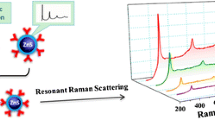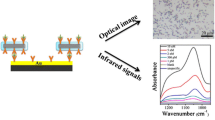Abstract
A reliable, rapid and ultrasensitive immunoassay is described for determination of immunoglobulin G (IgG). It is making use of biofunctional magnetite (Fe3O4) superparticles coated with SiO2 and serving as an infrared (IR) probe. The unique IR fingerprint signals originating from the transverse and longitudinal phonon modes, respectively, of the asymmetric stretching of the Si–O–Si bridges display a satisfactory resistance to optical interference from the environment. The adoption of Fe3O4 superparticles instead of Fe3O4 nanoparticles as the magnetic core warrants a controllable structure and a strong magnetic response. This facilitates the efficient purification of the probes and the alleviation of the interfacial resistance between the liquid-solid interfaces by using a magnet. The gold-coated substrate was used to immobilize goat-anti-human IgG. The analyte (human IgG) was incubated with the IR probes, and then captured by the substrate immobilized antibody with the assistance of an external magnetic field. The integral area of the IR absorption band between 1250 cm−1 – 900 cm−1 was chosen for quantitative assay. The limit of detection is 95 fM, which is two orders of magnitude better than that without the magnetic field. The assay time was shortened from 2 h to 1 min. High selectivity, specificity, and long-term stability of the immunoassay were achieved. The performance of the assay when analyzing blood samples confirmed the practicability of the method.

Schematic presentation of the infrared (IR) immunoassay based on Fe3O4 superparticle@SiO2 nanocomposites. The assistance of an external magnetic field reduces the incubation time and improves the detection sensitivity.




Similar content being viewed by others
References
Hlavacek A, Farka Z, Huebner M, Hornakova V, Nemecek D, Niessner R, Skladal P, Knopp D, Gorris HH (2016) Competitive upconversion-linked immunosorbent assay for the sensitive detection of diclofenac. Anal Chem 88(11):6011–6017. https://doi.org/10.1021/acs.analchem.6b01083
Wu X, Oo MKK, Reddy K, Chen Q, Sun Y, Fan X (2014) Optofluidic laser for dual-mode sensitive biomolecular detection with a large dynamic range. Nat Commun 5. https://doi.org/10.1038/ncomms4779
Wu L, Wang Z, Zong S, Huang Z, Zhang P, Cui Y (2012) A SERS-based immunoassay with highly increased sensitivity using gold/silver core-shell nanorods. Biosens Bioelectron 38(1):94–99. https://doi.org/10.1016/j.bios.2012.05.005
Yang K, Hu Y, Dong N, Zhu G, Zhu T, Jiang N (2017) A novel SERS-based magnetic aptasensor for prostate specific antigen assay with high sensitivity. Biosens Bioelectron 94:286–291. https://doi.org/10.1016/j.bios.2017.02.048
Li C, Zuo J, Li Q, Chang Y, Zhang Y, Tu L, Liu X, Xue B, Zhao H, Zhang H, Kong X (2017) One-step in situ solid-substrate-based whole blood immunoassay based on FRET between upconversion and gold nanoparticles. Biosens Bioelectron 92:335–341. https://doi.org/10.1016/j.bios.2016.11.003
Wen Y, Xing F, He S, Song S, Wang L, Long Y, Li D, Fan C (2010) A graphene-based fluorescent nanoprobe for silver(i) ions detection by using graphene oxide and a silver-specific oligonucleotide. Chem Commun 46(15):2596–2598. https://doi.org/10.1039/b924832c
Song S, Qin Y, He Y, Huang Q, Fan C, Chen H-Y (2010) Functional nanoprobes for ultrasensitive detection of biomolecules. Chem Soc Rev 39:4234–3243. https://doi.org/10.1039/c000682n
Alesker M, Heller A, Malik Z, Makarovsky I, Lellouche J-P (2011) Hybrid silica nanoparticles traceable by fluorescence and FT-IR spectroscopy: preparation, characterization and preliminary biological studies. J Mater Chem 21(29):10883–10893. https://doi.org/10.1039/c1jm11555c
Fischer-Durand N, Salmain M, Rudolf B, Dai L, Juge L, Guerineau V, Laprevote O, Vessieres A, Jaouen G (2010) Site-specific conjugation of metal carbonyl dendrimer to antibody and its use as detection reagent in immunoassay. Anal Biochem 407(2):211–219. https://doi.org/10.1016/j.ab.2010.08.027
Liao W, Wei F, Liu D, Qian MX, Yuan G, Zhao XS (2006) FTIR-ATR detection of proteins and small molecules through DNA conjugation. Sensors Actuators B Chem 114(1):445–450. https://doi.org/10.1016/j.snb.2005.06.021
Chen Y, Chen H, Shi J (2013) In vivo bio-safety evaluations and diagnostic/therapeutic applications of chemically designed mesoporous silica nanoparticles. Adv Mater 25(23):3144–3176. https://doi.org/10.1002/adma.201205292
Ding Y, Chu X, Hong X, Zou P, Liu Y (2012) The infrared fingerprint signals of silica nanoparticles and its application in immunoassay. Appl Phys Lett 100(1):013701. https://doi.org/10.1063/1.3673549
Zhao P, Ni R, Wang K, Hong X, Ding Y, Cong T, Liu J, Zhao H (2017) Dual-mode immunoassay based on shape code and infrared absorption fingerprint signals of silica nanorods. Anal Bioanal Chem 409(17):4207–4213. https://doi.org/10.1007/s00216-017-0369-8
Donato P, Le Nguyen KH (2015) Homogenization of diffusion problems with a nonlinear interfacial resistance. Nonlinear Differ Equ Appl 22(5):1345–1380
Harada M, Eguchi W, Imamura T, Fujiyoshi K (1975) Interfacial resistance in liquid-liquid mass transfer. J Chem Eng Jpn 8(3):233–238. https://doi.org/10.1252/jcej.8.233
Babamiri B, Hallaj R, Salimi A, Akhtari K (2017) Potential-resolved electrochemiluminescence immunoassay for simultaneous determination of CEA and AFP tumor markers using dendritic nanoclusters and Fe3O4@SiO2 nanoparticles. Microchim Acta 184(9):3613–3623. https://doi.org/10.1007/s00604-017-2386-x
Jiang H, Liu Y, Luo W, Wang Y, Tang X, Dou W, Cui Y, Liu W (2018) A resumable two-photon fluorescent probe for Cu2+ and S2− based on magnetic silica core-shell Fe3O4@SiO2 nanoparticles and its application in bioimaging. Anal Chim Acta 1014:91–99. https://doi.org/10.1016/j.aca.2018.02.006
Peterson RD, Chen W, Cunningham BT, Andrade JE (2015) Enhanced sandwich immunoassay using antibody-functionalized magnetic iron-oxide nanoparticles for extraction and detection of soluble transferrin receptor on a photonic crystal biosensor. Biosens Bioelectron 74:815–822. https://doi.org/10.1016/j.bios.2015.07.050
Singh G, Sanchita RS, Sharma G, Kalra P, Singh N, Verma V (2018) Coumarin-derived organosilatranes: functionalization at magnetic silica surface and selective recognition of Hg2+ ion. Sensors Actuators B Chem 266:861–872. https://doi.org/10.1016/j.snb.2018.03.036
Fu R, Jin X, Liang J, Zheng W, Zhuang J, Yang W (2011) Preparation of nearly monodispersed Fe3O4/SiO2 composite particles from aggregates of Fe3O4 nanoparticles. J Mater Chem 21(39):15352–15356. https://doi.org/10.1039/c1jm11883h
Zhuang J, Wu H, Yang Y, Cao YC (2008) Controlling colloidal superparticle growth through solvophobic interactions. Angew Chem Int Ed 47(12):2208–2212. https://doi.org/10.1002/anie.200705049
Zhuang J, Wu H, Yang Y, Cao YC (2007) Supercrystalline colloidal particles from artificial atoms. J Am Chem Soc 129(46):14166−+. https://doi.org/10.1021/ja076494i
Ding Y, Cong T, Chu X, Jia Y, Hong X, Liu Y (2016) Magnetic-bead-based sub-femtomolar immunoassay using resonant Raman scattering signals of ZnS nanoparticles. Anal Bioanal Chem 408(18):5013–5019. https://doi.org/10.1007/s00216-016-9601-1
Hong X, Chu X, Zou P, Liu Y, Yang G (2010) Magnetic-field-assisted rapid ultrasensitive immunoassays using Fe3O4/ZnO/Au nanorices as Raman probes. Biosens Bioelectron 26(2):918–922. https://doi.org/10.1016/j.bios.2010.06.066
Al-Oweini R, El-Rassy H (2009) Synthesis and characterization by FTIR spectroscopy of silica aerogels prepared using several Si(OR)4 and R”Si(OR')3 precursors. J Mol Struct 919 (1–3):140–145. https://doi.org/10.1016/j.molstruc.2008.08.025
Hu Q, Suzuki H, Gao H, Araki H, Yang W, Noda T (2003) High-frequency FTIR absorption of SiO2/Si nanowires. Chem Phys Lett 378(3–4):299–304. https://doi.org/10.1016/j.cplett.2003.07.015
Martínez JR, Ruiz F, Vorobiev YV, Pérez-Robles F, González-Hernández J (1998) Infrared spectroscopy analysis of the local atomic structure in silica prepared by sol-gel. J Chem Phys 109(17):7511–7514. https://doi.org/10.1063/1.477374
Buongiorno J (2006) Convective transport in nanofluids. J Heat Transfer 128(3):240–250. https://doi.org/10.1115/1.2150834
Wang S, Chen Z, Choo J, Chen L (2016) Naked-eye sensitive ELISA-like assay based on gold-enhanced peroxidase-like immunogold activity. Anal Bioanal Chem 408(4):1015–1022. https://doi.org/10.1007/s00216-015-9219-8
Zhu L, Cui X, Wu J, Wang Z, Wang P, Hou Y, Yang M (2014) Fluorescence immunoassay based on carbon dots as labels for the detection of human immunoglobulin G. Anal Methods 6(12):4430–4436. https://doi.org/10.1039/c4ay00717d
Shirai A, Henares TG, Sueyoshi K, Endo T, Hisamoto H (2016) Fast and single-step immunoassay based on fluorescence quenching within a square glass capillary immobilizing graphene oxide-antibody conjugate and fluorescently labelled antibody. Analyst 141(11):3389–3394. https://doi.org/10.1039/c5an02637g
Fu C, Gu Y, Wu Z, Wang Y, Xu S, Xu W (2014) Surface-enhanced Raman scattering (SERS) biosensing based on nanoporous dielectric waveguide resonance. Sensors Actuators B Chem 201:173–176. https://doi.org/10.1016/j.snb.2014.04.091
Balzerova A, Fargasova A, Markova Z, Ranc V, Zboril R (2014) Magnetically-assisted surface enhanced Raman spectroscopy (MA-SERS) for label-free determination of human immunoglobulin G (IgG) in blood using Fe3O4@Ag nanocomposite. Anal Chem 86(22):11107–11114. https://doi.org/10.1021/ac503347h
Tang D, Ren J, Lu M (2017) Multiplexed electrochemical immunoassay for two immunoglobulin proteins based on Cd and Cu nanocrystals. Analyst 142(24):4794–4800. https://doi.org/10.1039/c7an01459g
Li H, Zhao M, Liu W, Chu W, Guo Y (2016) Polydimethylsiloxane microfluidic chemiluminescence immunodevice with the signal amplification strategy for sensitive detection of human immunoglobin G. Talanta 147:430–436. https://doi.org/10.1016/j.talanta.2015.10.018
Acknowledgements
This work was supported by the National Natural Science Foundation of China (Grants No. 51272040 and 11604043), Thirteenth Five-Year Science and Technology Research Project of Education Department of Jilin Province (No. JJKH20170910KJ), Open Project of Key Laboratory for UV-Emitting Materials and Technology of Ministry of Education (130028853) and Project funded by China Postdoctoral Science Foundation (No. 2017 M611294).
Author information
Authors and Affiliations
Corresponding authors
Ethics declarations
The author(s) declare that they have no competing interests.
Additional information
Publisher’s note
Springer Nature remains neutral with regard to jurisdictional claims in published maps and institutional affiliations.
Electronic supplementary material
ESM 1
(DOCX 1517 kb)
Rights and permissions
About this article
Cite this article
Wang, K., Ding, Y., Hong, X. et al. An infrared IgG immunoassay based on the use of a nanocomposite consisting of silica coated Fe3O4 superparticles. Microchim Acta 186, 99 (2019). https://doi.org/10.1007/s00604-018-3219-2
Received:
Accepted:
Published:
DOI: https://doi.org/10.1007/s00604-018-3219-2




